Professional Practice and Development in Education and Training Report
VerifiedAdded on 2020/06/06
|15
|4930
|313
Report
AI Summary
This report delves into the multifaceted aspects of wider professional practice and development within the realm of education and training. It commences by elucidating the concepts of professionalism and dual professionalism, alongside an examination of how personal professional values influence practices within specialized areas. The report then transitions to analyze the impact of social, political, and economic factors on educational policy, and how current policies affect curriculum and practices. A significant portion is dedicated to exploring the roles of stakeholders and external bodies, and their influence on organizations, curriculum design, delivery, and assessment. Furthermore, the report scrutinizes quality improvements and assurance within an organization, including self-assessment, evaluation, and the quality cycle. It concludes with an evaluation of a learning program and suggestions for areas needing improvement, providing a comprehensive overview of the challenges and opportunities in educational practice.
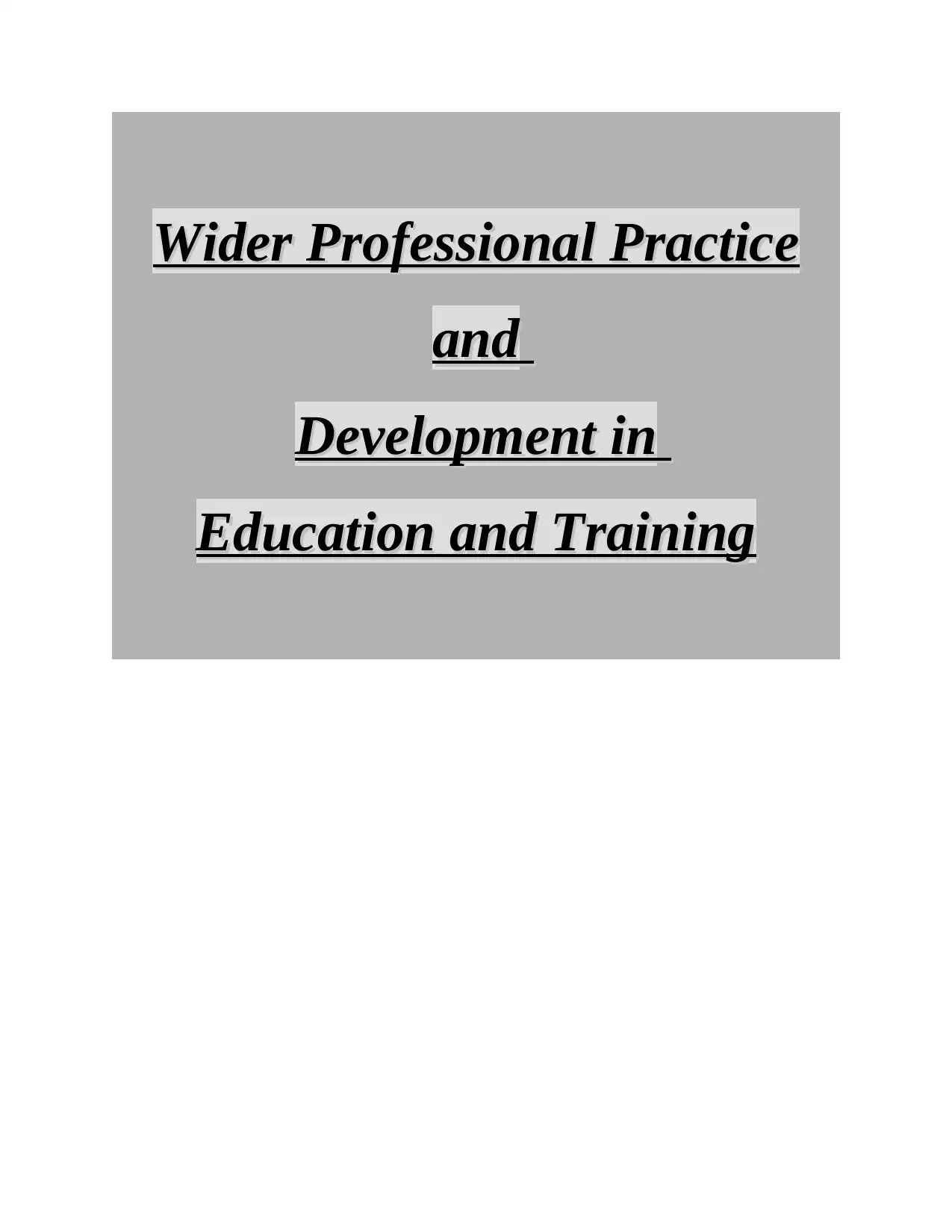
Wider Professional PracticeWider Professional Practice
andand
Development inDevelopment in
Education and TrainingEducation and Training
andand
Development inDevelopment in
Education and TrainingEducation and Training
Paraphrase This Document
Need a fresh take? Get an instant paraphrase of this document with our AI Paraphraser
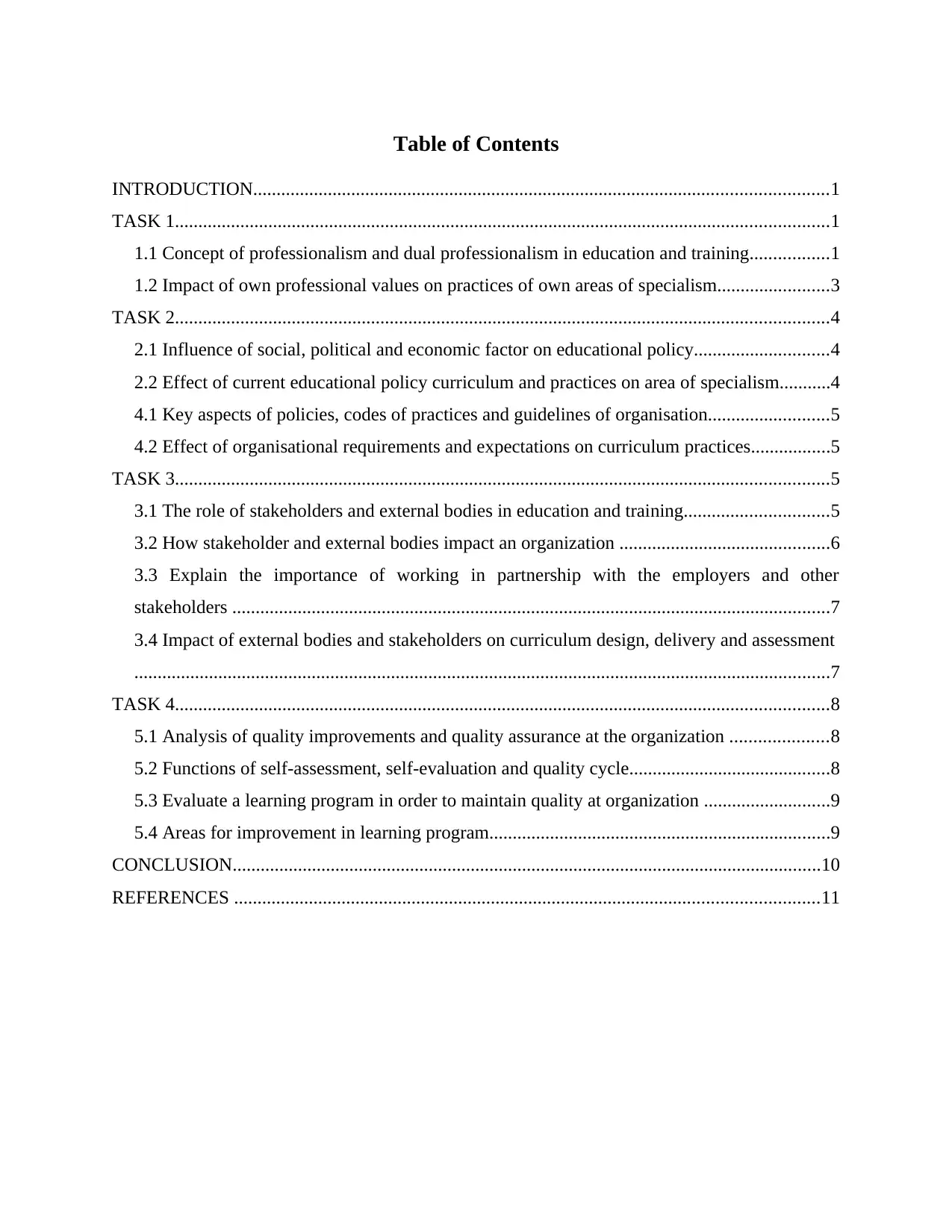
Table of Contents
INTRODUCTION...........................................................................................................................1
TASK 1............................................................................................................................................1
1.1 Concept of professionalism and dual professionalism in education and training.................1
1.2 Impact of own professional values on practices of own areas of specialism........................3
TASK 2............................................................................................................................................4
2.1 Influence of social, political and economic factor on educational policy.............................4
2.2 Effect of current educational policy curriculum and practices on area of specialism...........4
4.1 Key aspects of policies, codes of practices and guidelines of organisation..........................5
4.2 Effect of organisational requirements and expectations on curriculum practices.................5
TASK 3............................................................................................................................................5
3.1 The role of stakeholders and external bodies in education and training...............................5
3.2 How stakeholder and external bodies impact an organization .............................................6
3.3 Explain the importance of working in partnership with the employers and other
stakeholders ................................................................................................................................7
3.4 Impact of external bodies and stakeholders on curriculum design, delivery and assessment
.....................................................................................................................................................7
TASK 4............................................................................................................................................8
5.1 Analysis of quality improvements and quality assurance at the organization .....................8
5.2 Functions of self-assessment, self-evaluation and quality cycle...........................................8
5.3 Evaluate a learning program in order to maintain quality at organization ...........................9
5.4 Areas for improvement in learning program.........................................................................9
CONCLUSION..............................................................................................................................10
REFERENCES .............................................................................................................................11
INTRODUCTION...........................................................................................................................1
TASK 1............................................................................................................................................1
1.1 Concept of professionalism and dual professionalism in education and training.................1
1.2 Impact of own professional values on practices of own areas of specialism........................3
TASK 2............................................................................................................................................4
2.1 Influence of social, political and economic factor on educational policy.............................4
2.2 Effect of current educational policy curriculum and practices on area of specialism...........4
4.1 Key aspects of policies, codes of practices and guidelines of organisation..........................5
4.2 Effect of organisational requirements and expectations on curriculum practices.................5
TASK 3............................................................................................................................................5
3.1 The role of stakeholders and external bodies in education and training...............................5
3.2 How stakeholder and external bodies impact an organization .............................................6
3.3 Explain the importance of working in partnership with the employers and other
stakeholders ................................................................................................................................7
3.4 Impact of external bodies and stakeholders on curriculum design, delivery and assessment
.....................................................................................................................................................7
TASK 4............................................................................................................................................8
5.1 Analysis of quality improvements and quality assurance at the organization .....................8
5.2 Functions of self-assessment, self-evaluation and quality cycle...........................................8
5.3 Evaluate a learning program in order to maintain quality at organization ...........................9
5.4 Areas for improvement in learning program.........................................................................9
CONCLUSION..............................................................................................................................10
REFERENCES .............................................................................................................................11

⊘ This is a preview!⊘
Do you want full access?
Subscribe today to unlock all pages.

Trusted by 1+ million students worldwide
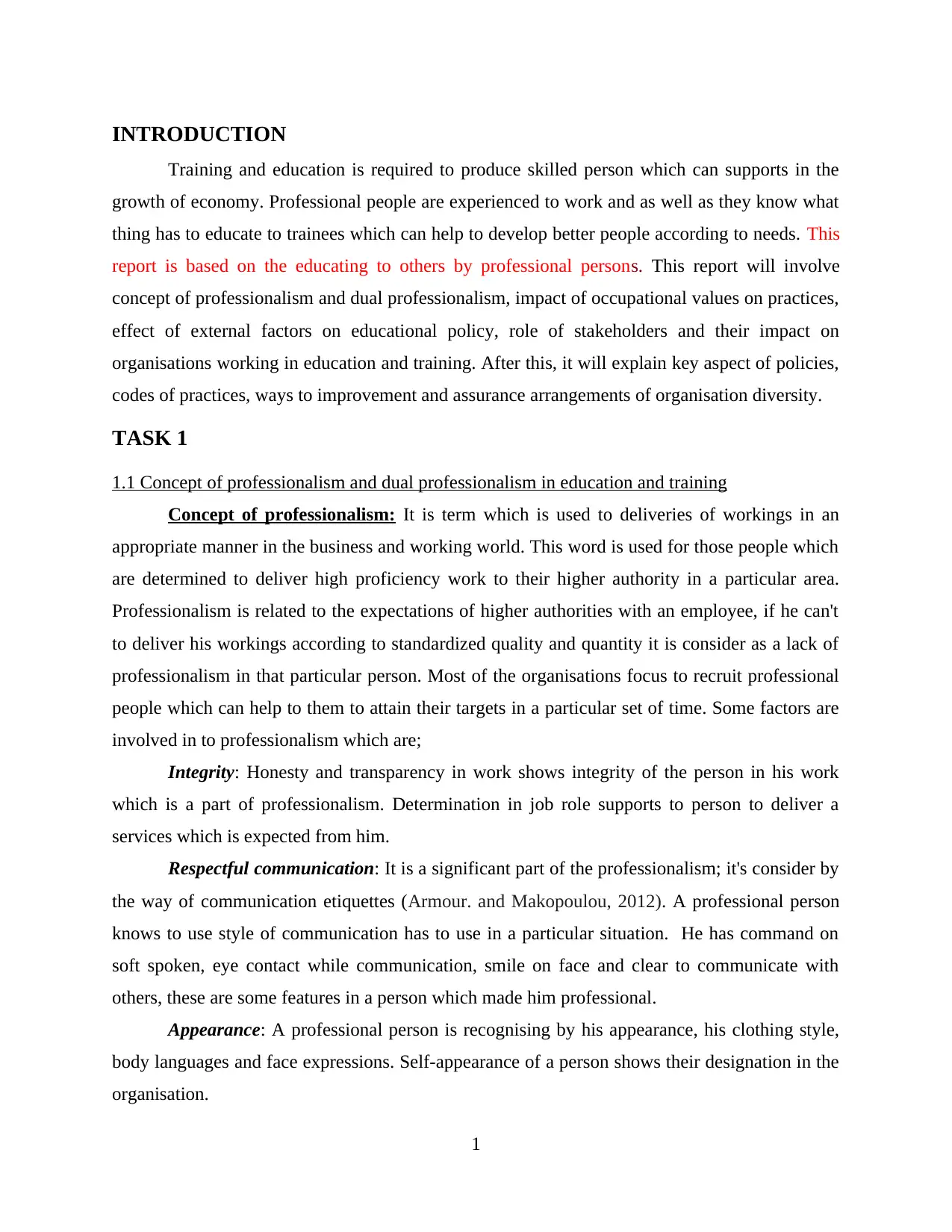
INTRODUCTION
Training and education is required to produce skilled person which can supports in the
growth of economy. Professional people are experienced to work and as well as they know what
thing has to educate to trainees which can help to develop better people according to needs. This
report is based on the educating to others by professional persons. This report will involve
concept of professionalism and dual professionalism, impact of occupational values on practices,
effect of external factors on educational policy, role of stakeholders and their impact on
organisations working in education and training. After this, it will explain key aspect of policies,
codes of practices, ways to improvement and assurance arrangements of organisation diversity.
TASK 1
1.1 Concept of professionalism and dual professionalism in education and training
Concept of professionalism: It is term which is used to deliveries of workings in an
appropriate manner in the business and working world. This word is used for those people which
are determined to deliver high proficiency work to their higher authority in a particular area.
Professionalism is related to the expectations of higher authorities with an employee, if he can't
to deliver his workings according to standardized quality and quantity it is consider as a lack of
professionalism in that particular person. Most of the organisations focus to recruit professional
people which can help to them to attain their targets in a particular set of time. Some factors are
involved in to professionalism which are;
Integrity: Honesty and transparency in work shows integrity of the person in his work
which is a part of professionalism. Determination in job role supports to person to deliver a
services which is expected from him.
Respectful communication: It is a significant part of the professionalism; it's consider by
the way of communication etiquettes (Armour. and Makopoulou, 2012). A professional person
knows to use style of communication has to use in a particular situation. He has command on
soft spoken, eye contact while communication, smile on face and clear to communicate with
others, these are some features in a person which made him professional.
Appearance: A professional person is recognising by his appearance, his clothing style,
body languages and face expressions. Self-appearance of a person shows their designation in the
organisation.
1
Training and education is required to produce skilled person which can supports in the
growth of economy. Professional people are experienced to work and as well as they know what
thing has to educate to trainees which can help to develop better people according to needs. This
report is based on the educating to others by professional persons. This report will involve
concept of professionalism and dual professionalism, impact of occupational values on practices,
effect of external factors on educational policy, role of stakeholders and their impact on
organisations working in education and training. After this, it will explain key aspect of policies,
codes of practices, ways to improvement and assurance arrangements of organisation diversity.
TASK 1
1.1 Concept of professionalism and dual professionalism in education and training
Concept of professionalism: It is term which is used to deliveries of workings in an
appropriate manner in the business and working world. This word is used for those people which
are determined to deliver high proficiency work to their higher authority in a particular area.
Professionalism is related to the expectations of higher authorities with an employee, if he can't
to deliver his workings according to standardized quality and quantity it is consider as a lack of
professionalism in that particular person. Most of the organisations focus to recruit professional
people which can help to them to attain their targets in a particular set of time. Some factors are
involved in to professionalism which are;
Integrity: Honesty and transparency in work shows integrity of the person in his work
which is a part of professionalism. Determination in job role supports to person to deliver a
services which is expected from him.
Respectful communication: It is a significant part of the professionalism; it's consider by
the way of communication etiquettes (Armour. and Makopoulou, 2012). A professional person
knows to use style of communication has to use in a particular situation. He has command on
soft spoken, eye contact while communication, smile on face and clear to communicate with
others, these are some features in a person which made him professional.
Appearance: A professional person is recognising by his appearance, his clothing style,
body languages and face expressions. Self-appearance of a person shows their designation in the
organisation.
1
Paraphrase This Document
Need a fresh take? Get an instant paraphrase of this document with our AI Paraphraser
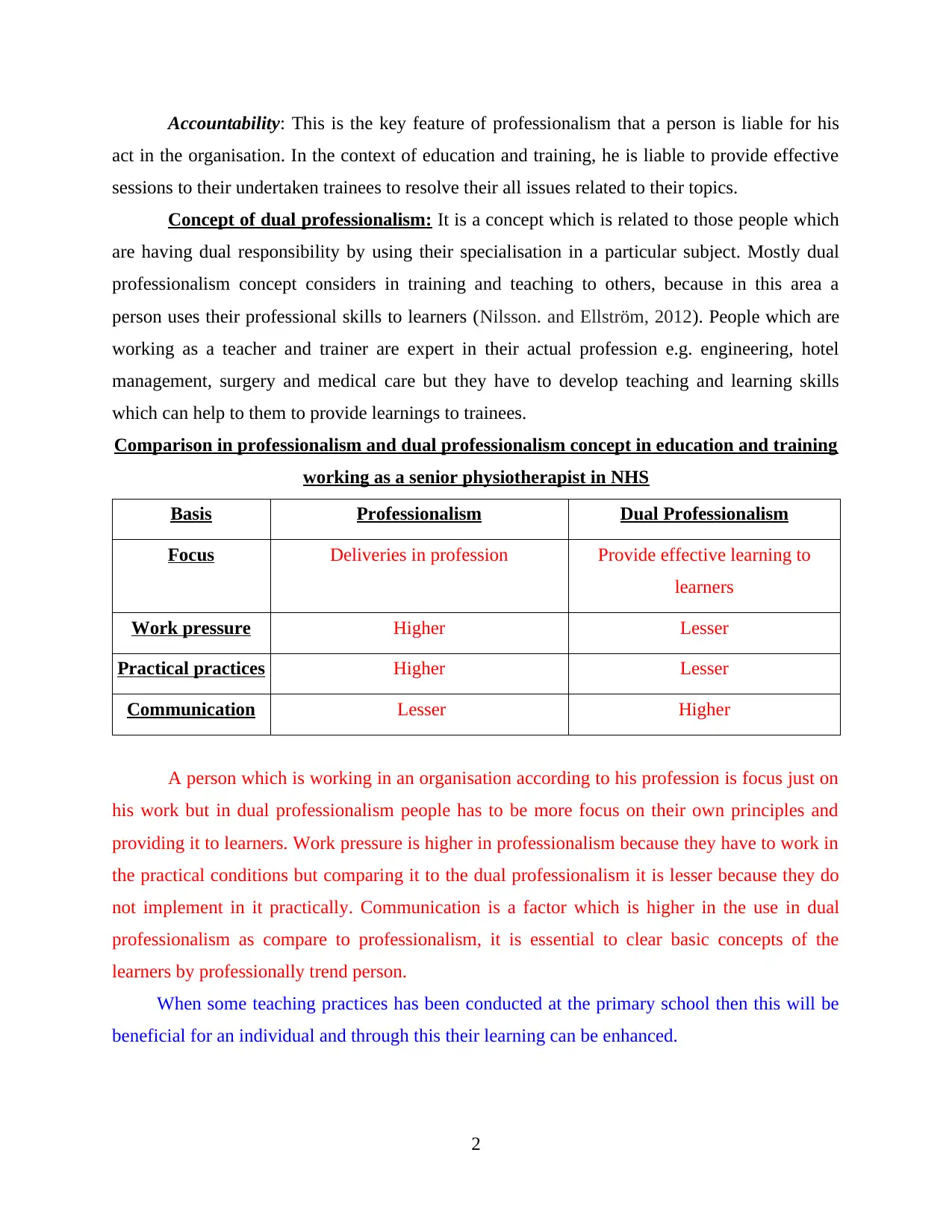
Accountability: This is the key feature of professionalism that a person is liable for his
act in the organisation. In the context of education and training, he is liable to provide effective
sessions to their undertaken trainees to resolve their all issues related to their topics.
Concept of dual professionalism: It is a concept which is related to those people which
are having dual responsibility by using their specialisation in a particular subject. Mostly dual
professionalism concept considers in training and teaching to others, because in this area a
person uses their professional skills to learners (Nilsson. and Ellström, 2012). People which are
working as a teacher and trainer are expert in their actual profession e.g. engineering, hotel
management, surgery and medical care but they have to develop teaching and learning skills
which can help to them to provide learnings to trainees.
Comparison in professionalism and dual professionalism concept in education and training
working as a senior physiotherapist in NHS
Basis Professionalism Dual Professionalism
Focus Deliveries in profession Provide effective learning to
learners
Work pressure Higher Lesser
Practical practices Higher Lesser
Communication Lesser Higher
A person which is working in an organisation according to his profession is focus just on
his work but in dual professionalism people has to be more focus on their own principles and
providing it to learners. Work pressure is higher in professionalism because they have to work in
the practical conditions but comparing it to the dual professionalism it is lesser because they do
not implement in it practically. Communication is a factor which is higher in the use in dual
professionalism as compare to professionalism, it is essential to clear basic concepts of the
learners by professionally trend person.
When some teaching practices has been conducted at the primary school then this will be
beneficial for an individual and through this their learning can be enhanced.
2
act in the organisation. In the context of education and training, he is liable to provide effective
sessions to their undertaken trainees to resolve their all issues related to their topics.
Concept of dual professionalism: It is a concept which is related to those people which
are having dual responsibility by using their specialisation in a particular subject. Mostly dual
professionalism concept considers in training and teaching to others, because in this area a
person uses their professional skills to learners (Nilsson. and Ellström, 2012). People which are
working as a teacher and trainer are expert in their actual profession e.g. engineering, hotel
management, surgery and medical care but they have to develop teaching and learning skills
which can help to them to provide learnings to trainees.
Comparison in professionalism and dual professionalism concept in education and training
working as a senior physiotherapist in NHS
Basis Professionalism Dual Professionalism
Focus Deliveries in profession Provide effective learning to
learners
Work pressure Higher Lesser
Practical practices Higher Lesser
Communication Lesser Higher
A person which is working in an organisation according to his profession is focus just on
his work but in dual professionalism people has to be more focus on their own principles and
providing it to learners. Work pressure is higher in professionalism because they have to work in
the practical conditions but comparing it to the dual professionalism it is lesser because they do
not implement in it practically. Communication is a factor which is higher in the use in dual
professionalism as compare to professionalism, it is essential to clear basic concepts of the
learners by professionally trend person.
When some teaching practices has been conducted at the primary school then this will be
beneficial for an individual and through this their learning can be enhanced.
2
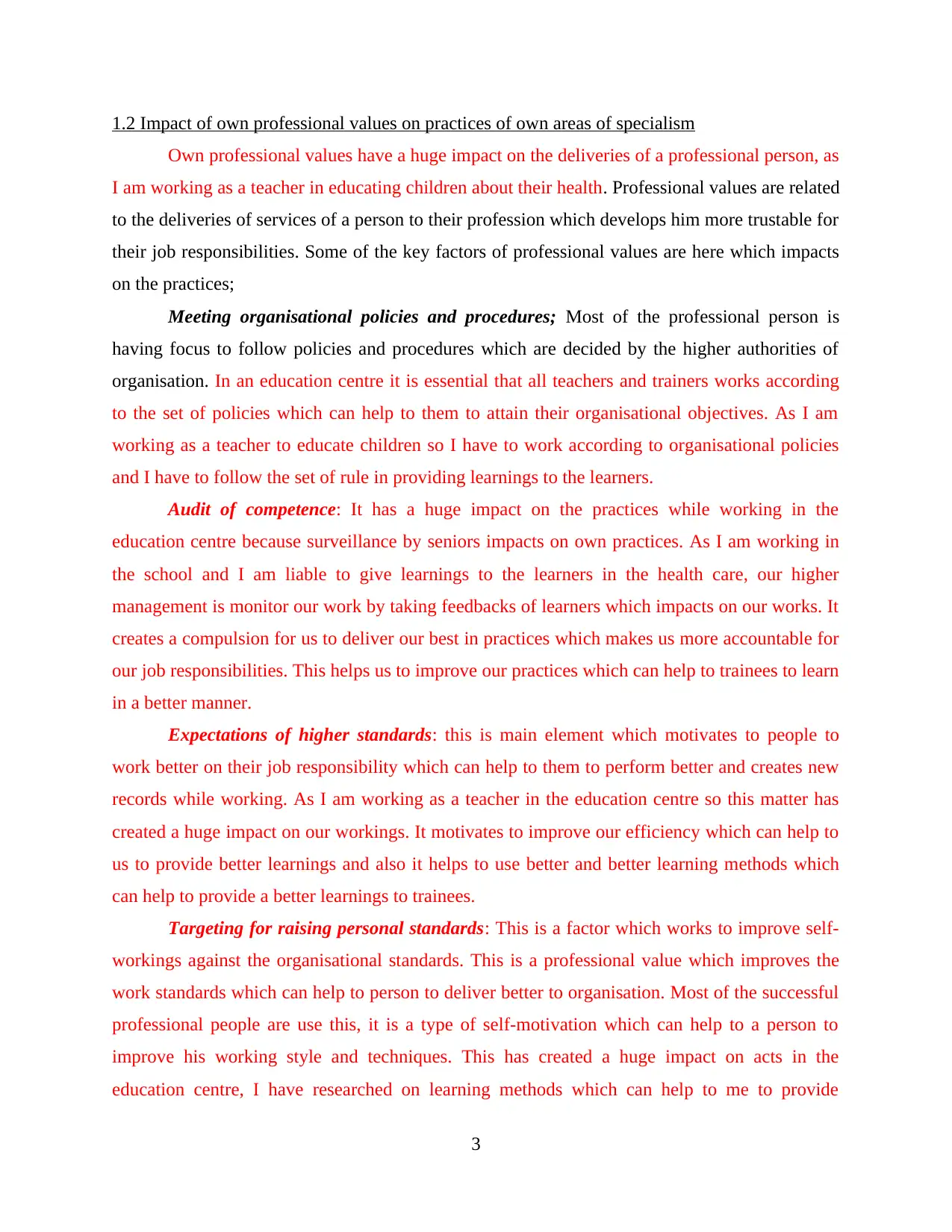
1.2 Impact of own professional values on practices of own areas of specialism
Own professional values have a huge impact on the deliveries of a professional person, as
I am working as a teacher in educating children about their health. Professional values are related
to the deliveries of services of a person to their profession which develops him more trustable for
their job responsibilities. Some of the key factors of professional values are here which impacts
on the practices;
Meeting organisational policies and procedures; Most of the professional person is
having focus to follow policies and procedures which are decided by the higher authorities of
organisation. In an education centre it is essential that all teachers and trainers works according
to the set of policies which can help to them to attain their organisational objectives. As I am
working as a teacher to educate children so I have to work according to organisational policies
and I have to follow the set of rule in providing learnings to the learners.
Audit of competence: It has a huge impact on the practices while working in the
education centre because surveillance by seniors impacts on own practices. As I am working in
the school and I am liable to give learnings to the learners in the health care, our higher
management is monitor our work by taking feedbacks of learners which impacts on our works. It
creates a compulsion for us to deliver our best in practices which makes us more accountable for
our job responsibilities. This helps us to improve our practices which can help to trainees to learn
in a better manner.
Expectations of higher standards: this is main element which motivates to people to
work better on their job responsibility which can help to them to perform better and creates new
records while working. As I am working as a teacher in the education centre so this matter has
created a huge impact on our workings. It motivates to improve our efficiency which can help to
us to provide better learnings and also it helps to use better and better learning methods which
can help to provide a better learnings to trainees.
Targeting for raising personal standards: This is a factor which works to improve self-
workings against the organisational standards. This is a professional value which improves the
work standards which can help to person to deliver better to organisation. Most of the successful
professional people are use this, it is a type of self-motivation which can help to a person to
improve his working style and techniques. This has created a huge impact on acts in the
education centre, I have researched on learning methods which can help to me to provide
3
Own professional values have a huge impact on the deliveries of a professional person, as
I am working as a teacher in educating children about their health. Professional values are related
to the deliveries of services of a person to their profession which develops him more trustable for
their job responsibilities. Some of the key factors of professional values are here which impacts
on the practices;
Meeting organisational policies and procedures; Most of the professional person is
having focus to follow policies and procedures which are decided by the higher authorities of
organisation. In an education centre it is essential that all teachers and trainers works according
to the set of policies which can help to them to attain their organisational objectives. As I am
working as a teacher to educate children so I have to work according to organisational policies
and I have to follow the set of rule in providing learnings to the learners.
Audit of competence: It has a huge impact on the practices while working in the
education centre because surveillance by seniors impacts on own practices. As I am working in
the school and I am liable to give learnings to the learners in the health care, our higher
management is monitor our work by taking feedbacks of learners which impacts on our works. It
creates a compulsion for us to deliver our best in practices which makes us more accountable for
our job responsibilities. This helps us to improve our practices which can help to trainees to learn
in a better manner.
Expectations of higher standards: this is main element which motivates to people to
work better on their job responsibility which can help to them to perform better and creates new
records while working. As I am working as a teacher in the education centre so this matter has
created a huge impact on our workings. It motivates to improve our efficiency which can help to
us to provide better learnings and also it helps to use better and better learning methods which
can help to provide a better learnings to trainees.
Targeting for raising personal standards: This is a factor which works to improve self-
workings against the organisational standards. This is a professional value which improves the
work standards which can help to person to deliver better to organisation. Most of the successful
professional people are use this, it is a type of self-motivation which can help to a person to
improve his working style and techniques. This has created a huge impact on acts in the
education centre, I have researched on learning methods which can help to me to provide
3
⊘ This is a preview!⊘
Do you want full access?
Subscribe today to unlock all pages.

Trusted by 1+ million students worldwide
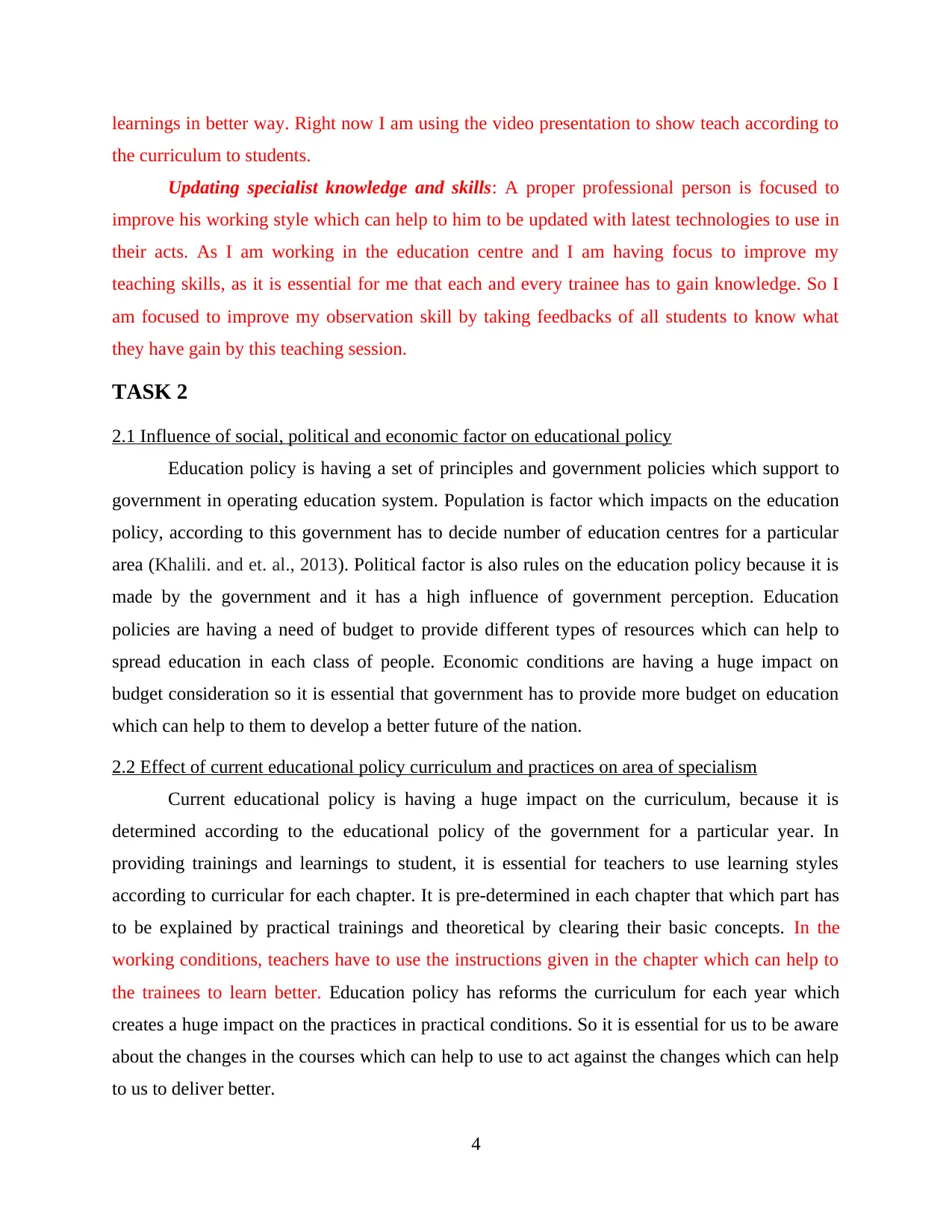
learnings in better way. Right now I am using the video presentation to show teach according to
the curriculum to students.
Updating specialist knowledge and skills: A proper professional person is focused to
improve his working style which can help to him to be updated with latest technologies to use in
their acts. As I am working in the education centre and I am having focus to improve my
teaching skills, as it is essential for me that each and every trainee has to gain knowledge. So I
am focused to improve my observation skill by taking feedbacks of all students to know what
they have gain by this teaching session.
TASK 2
2.1 Influence of social, political and economic factor on educational policy
Education policy is having a set of principles and government policies which support to
government in operating education system. Population is factor which impacts on the education
policy, according to this government has to decide number of education centres for a particular
area (Khalili. and et. al., 2013). Political factor is also rules on the education policy because it is
made by the government and it has a high influence of government perception. Education
policies are having a need of budget to provide different types of resources which can help to
spread education in each class of people. Economic conditions are having a huge impact on
budget consideration so it is essential that government has to provide more budget on education
which can help to them to develop a better future of the nation.
2.2 Effect of current educational policy curriculum and practices on area of specialism
Current educational policy is having a huge impact on the curriculum, because it is
determined according to the educational policy of the government for a particular year. In
providing trainings and learnings to student, it is essential for teachers to use learning styles
according to curricular for each chapter. It is pre-determined in each chapter that which part has
to be explained by practical trainings and theoretical by clearing their basic concepts. In the
working conditions, teachers have to use the instructions given in the chapter which can help to
the trainees to learn better. Education policy has reforms the curriculum for each year which
creates a huge impact on the practices in practical conditions. So it is essential for us to be aware
about the changes in the courses which can help to use to act against the changes which can help
to us to deliver better.
4
the curriculum to students.
Updating specialist knowledge and skills: A proper professional person is focused to
improve his working style which can help to him to be updated with latest technologies to use in
their acts. As I am working in the education centre and I am having focus to improve my
teaching skills, as it is essential for me that each and every trainee has to gain knowledge. So I
am focused to improve my observation skill by taking feedbacks of all students to know what
they have gain by this teaching session.
TASK 2
2.1 Influence of social, political and economic factor on educational policy
Education policy is having a set of principles and government policies which support to
government in operating education system. Population is factor which impacts on the education
policy, according to this government has to decide number of education centres for a particular
area (Khalili. and et. al., 2013). Political factor is also rules on the education policy because it is
made by the government and it has a high influence of government perception. Education
policies are having a need of budget to provide different types of resources which can help to
spread education in each class of people. Economic conditions are having a huge impact on
budget consideration so it is essential that government has to provide more budget on education
which can help to them to develop a better future of the nation.
2.2 Effect of current educational policy curriculum and practices on area of specialism
Current educational policy is having a huge impact on the curriculum, because it is
determined according to the educational policy of the government for a particular year. In
providing trainings and learnings to student, it is essential for teachers to use learning styles
according to curricular for each chapter. It is pre-determined in each chapter that which part has
to be explained by practical trainings and theoretical by clearing their basic concepts. In the
working conditions, teachers have to use the instructions given in the chapter which can help to
the trainees to learn better. Education policy has reforms the curriculum for each year which
creates a huge impact on the practices in practical conditions. So it is essential for us to be aware
about the changes in the courses which can help to use to act against the changes which can help
to us to deliver better.
4
Paraphrase This Document
Need a fresh take? Get an instant paraphrase of this document with our AI Paraphraser
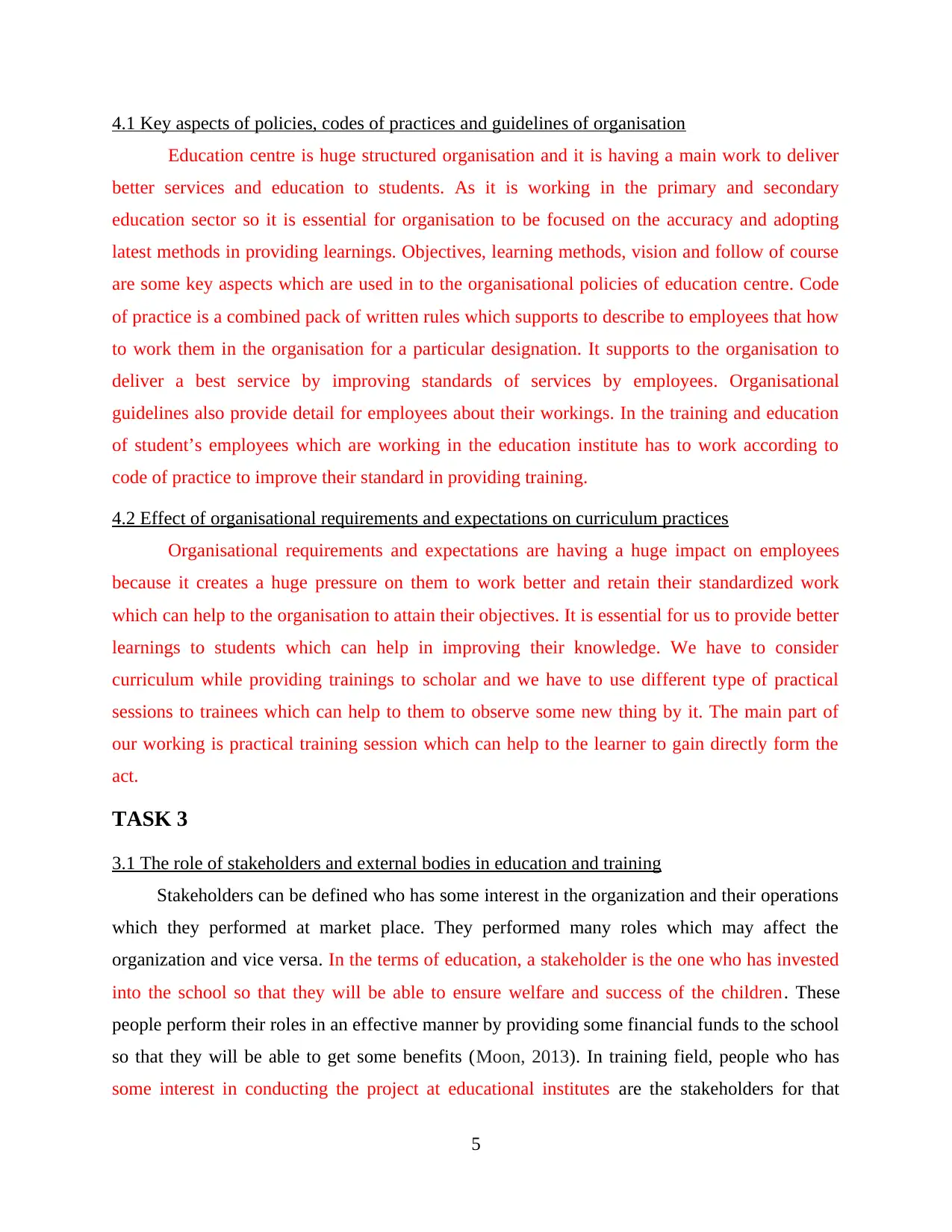
4.1 Key aspects of policies, codes of practices and guidelines of organisation
Education centre is huge structured organisation and it is having a main work to deliver
better services and education to students. As it is working in the primary and secondary
education sector so it is essential for organisation to be focused on the accuracy and adopting
latest methods in providing learnings. Objectives, learning methods, vision and follow of course
are some key aspects which are used in to the organisational policies of education centre. Code
of practice is a combined pack of written rules which supports to describe to employees that how
to work them in the organisation for a particular designation. It supports to the organisation to
deliver a best service by improving standards of services by employees. Organisational
guidelines also provide detail for employees about their workings. In the training and education
of student’s employees which are working in the education institute has to work according to
code of practice to improve their standard in providing training.
4.2 Effect of organisational requirements and expectations on curriculum practices
Organisational requirements and expectations are having a huge impact on employees
because it creates a huge pressure on them to work better and retain their standardized work
which can help to the organisation to attain their objectives. It is essential for us to provide better
learnings to students which can help in improving their knowledge. We have to consider
curriculum while providing trainings to scholar and we have to use different type of practical
sessions to trainees which can help to them to observe some new thing by it. The main part of
our working is practical training session which can help to the learner to gain directly form the
act.
TASK 3
3.1 The role of stakeholders and external bodies in education and training
Stakeholders can be defined who has some interest in the organization and their operations
which they performed at market place. They performed many roles which may affect the
organization and vice versa. In the terms of education, a stakeholder is the one who has invested
into the school so that they will be able to ensure welfare and success of the children. These
people perform their roles in an effective manner by providing some financial funds to the school
so that they will be able to get some benefits (Moon, 2013). In training field, people who has
some interest in conducting the project at educational institutes are the stakeholders for that
5
Education centre is huge structured organisation and it is having a main work to deliver
better services and education to students. As it is working in the primary and secondary
education sector so it is essential for organisation to be focused on the accuracy and adopting
latest methods in providing learnings. Objectives, learning methods, vision and follow of course
are some key aspects which are used in to the organisational policies of education centre. Code
of practice is a combined pack of written rules which supports to describe to employees that how
to work them in the organisation for a particular designation. It supports to the organisation to
deliver a best service by improving standards of services by employees. Organisational
guidelines also provide detail for employees about their workings. In the training and education
of student’s employees which are working in the education institute has to work according to
code of practice to improve their standard in providing training.
4.2 Effect of organisational requirements and expectations on curriculum practices
Organisational requirements and expectations are having a huge impact on employees
because it creates a huge pressure on them to work better and retain their standardized work
which can help to the organisation to attain their objectives. It is essential for us to provide better
learnings to students which can help in improving their knowledge. We have to consider
curriculum while providing trainings to scholar and we have to use different type of practical
sessions to trainees which can help to them to observe some new thing by it. The main part of
our working is practical training session which can help to the learner to gain directly form the
act.
TASK 3
3.1 The role of stakeholders and external bodies in education and training
Stakeholders can be defined who has some interest in the organization and their operations
which they performed at market place. They performed many roles which may affect the
organization and vice versa. In the terms of education, a stakeholder is the one who has invested
into the school so that they will be able to ensure welfare and success of the children. These
people perform their roles in an effective manner by providing some financial funds to the school
so that they will be able to get some benefits (Moon, 2013). In training field, people who has
some interest in conducting the project at educational institutes are the stakeholders for that
5
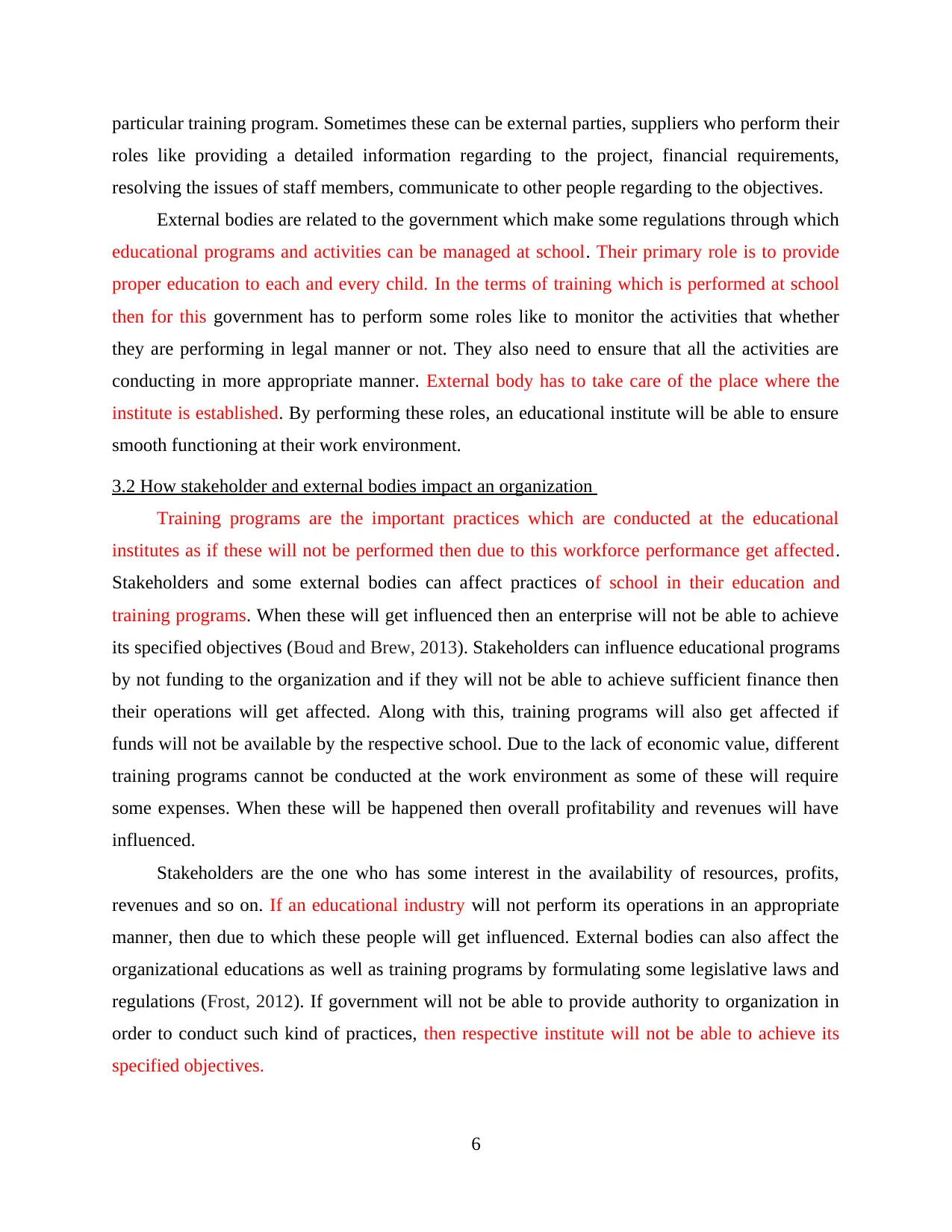
particular training program. Sometimes these can be external parties, suppliers who perform their
roles like providing a detailed information regarding to the project, financial requirements,
resolving the issues of staff members, communicate to other people regarding to the objectives.
External bodies are related to the government which make some regulations through which
educational programs and activities can be managed at school. Their primary role is to provide
proper education to each and every child. In the terms of training which is performed at school
then for this government has to perform some roles like to monitor the activities that whether
they are performing in legal manner or not. They also need to ensure that all the activities are
conducting in more appropriate manner. External body has to take care of the place where the
institute is established. By performing these roles, an educational institute will be able to ensure
smooth functioning at their work environment.
3.2 How stakeholder and external bodies impact an organization
Training programs are the important practices which are conducted at the educational
institutes as if these will not be performed then due to this workforce performance get affected.
Stakeholders and some external bodies can affect practices of school in their education and
training programs. When these will get influenced then an enterprise will not be able to achieve
its specified objectives (Boud and Brew, 2013). Stakeholders can influence educational programs
by not funding to the organization and if they will not be able to achieve sufficient finance then
their operations will get affected. Along with this, training programs will also get affected if
funds will not be available by the respective school. Due to the lack of economic value, different
training programs cannot be conducted at the work environment as some of these will require
some expenses. When these will be happened then overall profitability and revenues will have
influenced.
Stakeholders are the one who has some interest in the availability of resources, profits,
revenues and so on. If an educational industry will not perform its operations in an appropriate
manner, then due to which these people will get influenced. External bodies can also affect the
organizational educations as well as training programs by formulating some legislative laws and
regulations (Frost, 2012). If government will not be able to provide authority to organization in
order to conduct such kind of practices, then respective institute will not be able to achieve its
specified objectives.
6
roles like providing a detailed information regarding to the project, financial requirements,
resolving the issues of staff members, communicate to other people regarding to the objectives.
External bodies are related to the government which make some regulations through which
educational programs and activities can be managed at school. Their primary role is to provide
proper education to each and every child. In the terms of training which is performed at school
then for this government has to perform some roles like to monitor the activities that whether
they are performing in legal manner or not. They also need to ensure that all the activities are
conducting in more appropriate manner. External body has to take care of the place where the
institute is established. By performing these roles, an educational institute will be able to ensure
smooth functioning at their work environment.
3.2 How stakeholder and external bodies impact an organization
Training programs are the important practices which are conducted at the educational
institutes as if these will not be performed then due to this workforce performance get affected.
Stakeholders and some external bodies can affect practices of school in their education and
training programs. When these will get influenced then an enterprise will not be able to achieve
its specified objectives (Boud and Brew, 2013). Stakeholders can influence educational programs
by not funding to the organization and if they will not be able to achieve sufficient finance then
their operations will get affected. Along with this, training programs will also get affected if
funds will not be available by the respective school. Due to the lack of economic value, different
training programs cannot be conducted at the work environment as some of these will require
some expenses. When these will be happened then overall profitability and revenues will have
influenced.
Stakeholders are the one who has some interest in the availability of resources, profits,
revenues and so on. If an educational industry will not perform its operations in an appropriate
manner, then due to which these people will get influenced. External bodies can also affect the
organizational educations as well as training programs by formulating some legislative laws and
regulations (Frost, 2012). If government will not be able to provide authority to organization in
order to conduct such kind of practices, then respective institute will not be able to achieve its
specified objectives.
6
⊘ This is a preview!⊘
Do you want full access?
Subscribe today to unlock all pages.

Trusted by 1+ million students worldwide
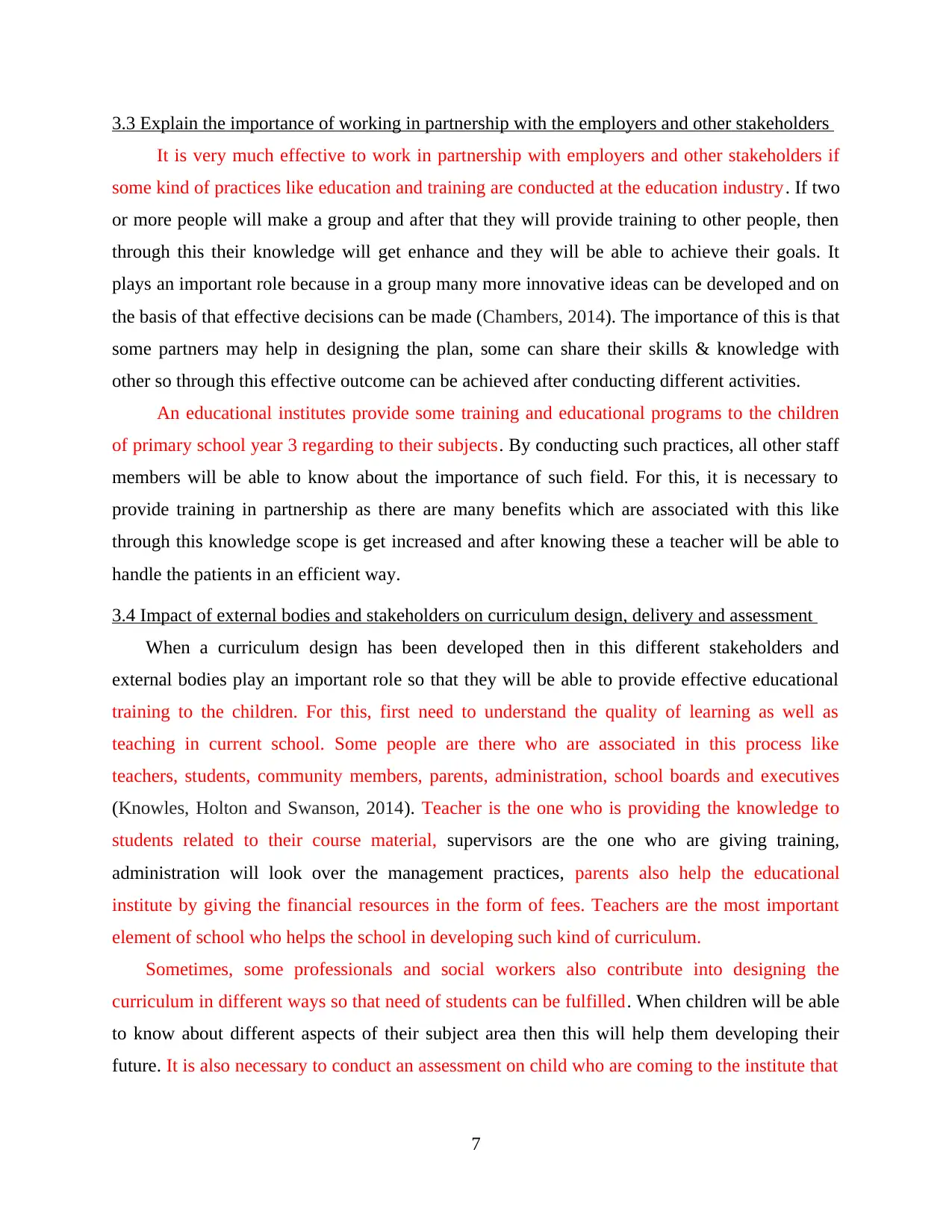
3.3 Explain the importance of working in partnership with the employers and other stakeholders
It is very much effective to work in partnership with employers and other stakeholders if
some kind of practices like education and training are conducted at the education industry. If two
or more people will make a group and after that they will provide training to other people, then
through this their knowledge will get enhance and they will be able to achieve their goals. It
plays an important role because in a group many more innovative ideas can be developed and on
the basis of that effective decisions can be made (Chambers, 2014). The importance of this is that
some partners may help in designing the plan, some can share their skills & knowledge with
other so through this effective outcome can be achieved after conducting different activities.
An educational institutes provide some training and educational programs to the children
of primary school year 3 regarding to their subjects. By conducting such practices, all other staff
members will be able to know about the importance of such field. For this, it is necessary to
provide training in partnership as there are many benefits which are associated with this like
through this knowledge scope is get increased and after knowing these a teacher will be able to
handle the patients in an efficient way.
3.4 Impact of external bodies and stakeholders on curriculum design, delivery and assessment
When a curriculum design has been developed then in this different stakeholders and
external bodies play an important role so that they will be able to provide effective educational
training to the children. For this, first need to understand the quality of learning as well as
teaching in current school. Some people are there who are associated in this process like
teachers, students, community members, parents, administration, school boards and executives
(Knowles, Holton and Swanson, 2014). Teacher is the one who is providing the knowledge to
students related to their course material, supervisors are the one who are giving training,
administration will look over the management practices, parents also help the educational
institute by giving the financial resources in the form of fees. Teachers are the most important
element of school who helps the school in developing such kind of curriculum.
Sometimes, some professionals and social workers also contribute into designing the
curriculum in different ways so that need of students can be fulfilled. When children will be able
to know about different aspects of their subject area then this will help them developing their
future. It is also necessary to conduct an assessment on child who are coming to the institute that
7
It is very much effective to work in partnership with employers and other stakeholders if
some kind of practices like education and training are conducted at the education industry. If two
or more people will make a group and after that they will provide training to other people, then
through this their knowledge will get enhance and they will be able to achieve their goals. It
plays an important role because in a group many more innovative ideas can be developed and on
the basis of that effective decisions can be made (Chambers, 2014). The importance of this is that
some partners may help in designing the plan, some can share their skills & knowledge with
other so through this effective outcome can be achieved after conducting different activities.
An educational institutes provide some training and educational programs to the children
of primary school year 3 regarding to their subjects. By conducting such practices, all other staff
members will be able to know about the importance of such field. For this, it is necessary to
provide training in partnership as there are many benefits which are associated with this like
through this knowledge scope is get increased and after knowing these a teacher will be able to
handle the patients in an efficient way.
3.4 Impact of external bodies and stakeholders on curriculum design, delivery and assessment
When a curriculum design has been developed then in this different stakeholders and
external bodies play an important role so that they will be able to provide effective educational
training to the children. For this, first need to understand the quality of learning as well as
teaching in current school. Some people are there who are associated in this process like
teachers, students, community members, parents, administration, school boards and executives
(Knowles, Holton and Swanson, 2014). Teacher is the one who is providing the knowledge to
students related to their course material, supervisors are the one who are giving training,
administration will look over the management practices, parents also help the educational
institute by giving the financial resources in the form of fees. Teachers are the most important
element of school who helps the school in developing such kind of curriculum.
Sometimes, some professionals and social workers also contribute into designing the
curriculum in different ways so that need of students can be fulfilled. When children will be able
to know about different aspects of their subject area then this will help them developing their
future. It is also necessary to conduct an assessment on child who are coming to the institute that
7
Paraphrase This Document
Need a fresh take? Get an instant paraphrase of this document with our AI Paraphraser
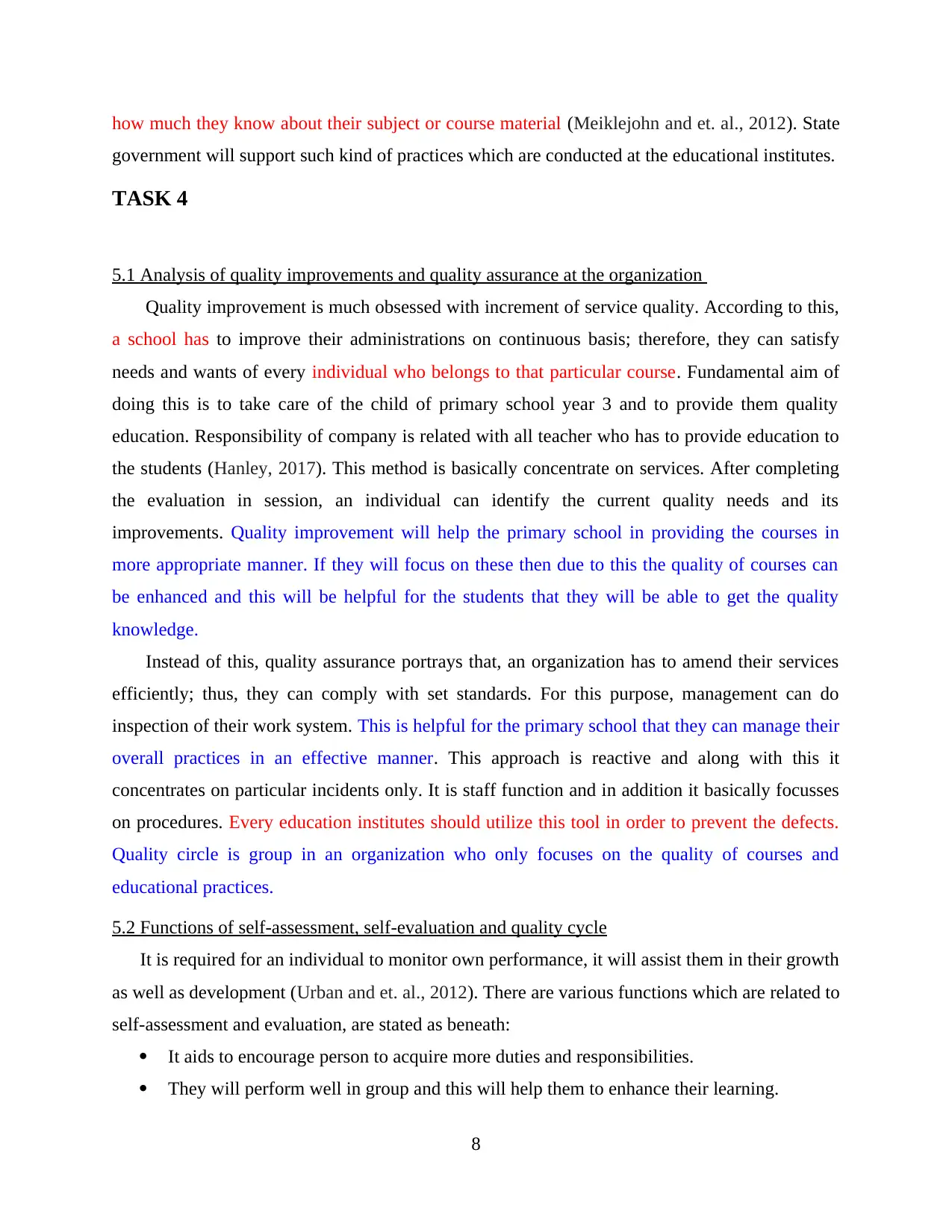
how much they know about their subject or course material (Meiklejohn and et. al., 2012). State
government will support such kind of practices which are conducted at the educational institutes.
TASK 4
5.1 Analysis of quality improvements and quality assurance at the organization
Quality improvement is much obsessed with increment of service quality. According to this,
a school has to improve their administrations on continuous basis; therefore, they can satisfy
needs and wants of every individual who belongs to that particular course. Fundamental aim of
doing this is to take care of the child of primary school year 3 and to provide them quality
education. Responsibility of company is related with all teacher who has to provide education to
the students (Hanley, 2017). This method is basically concentrate on services. After completing
the evaluation in session, an individual can identify the current quality needs and its
improvements. Quality improvement will help the primary school in providing the courses in
more appropriate manner. If they will focus on these then due to this the quality of courses can
be enhanced and this will be helpful for the students that they will be able to get the quality
knowledge.
Instead of this, quality assurance portrays that, an organization has to amend their services
efficiently; thus, they can comply with set standards. For this purpose, management can do
inspection of their work system. This is helpful for the primary school that they can manage their
overall practices in an effective manner. This approach is reactive and along with this it
concentrates on particular incidents only. It is staff function and in addition it basically focusses
on procedures. Every education institutes should utilize this tool in order to prevent the defects.
Quality circle is group in an organization who only focuses on the quality of courses and
educational practices.
5.2 Functions of self-assessment, self-evaluation and quality cycle
It is required for an individual to monitor own performance, it will assist them in their growth
as well as development (Urban and et. al., 2012). There are various functions which are related to
self-assessment and evaluation, are stated as beneath:
It aids to encourage person to acquire more duties and responsibilities.
They will perform well in group and this will help them to enhance their learning.
8
government will support such kind of practices which are conducted at the educational institutes.
TASK 4
5.1 Analysis of quality improvements and quality assurance at the organization
Quality improvement is much obsessed with increment of service quality. According to this,
a school has to improve their administrations on continuous basis; therefore, they can satisfy
needs and wants of every individual who belongs to that particular course. Fundamental aim of
doing this is to take care of the child of primary school year 3 and to provide them quality
education. Responsibility of company is related with all teacher who has to provide education to
the students (Hanley, 2017). This method is basically concentrate on services. After completing
the evaluation in session, an individual can identify the current quality needs and its
improvements. Quality improvement will help the primary school in providing the courses in
more appropriate manner. If they will focus on these then due to this the quality of courses can
be enhanced and this will be helpful for the students that they will be able to get the quality
knowledge.
Instead of this, quality assurance portrays that, an organization has to amend their services
efficiently; thus, they can comply with set standards. For this purpose, management can do
inspection of their work system. This is helpful for the primary school that they can manage their
overall practices in an effective manner. This approach is reactive and along with this it
concentrates on particular incidents only. It is staff function and in addition it basically focusses
on procedures. Every education institutes should utilize this tool in order to prevent the defects.
Quality circle is group in an organization who only focuses on the quality of courses and
educational practices.
5.2 Functions of self-assessment, self-evaluation and quality cycle
It is required for an individual to monitor own performance, it will assist them in their growth
as well as development (Urban and et. al., 2012). There are various functions which are related to
self-assessment and evaluation, are stated as beneath:
It aids to encourage person to acquire more duties and responsibilities.
They will perform well in group and this will help them to enhance their learning.
8
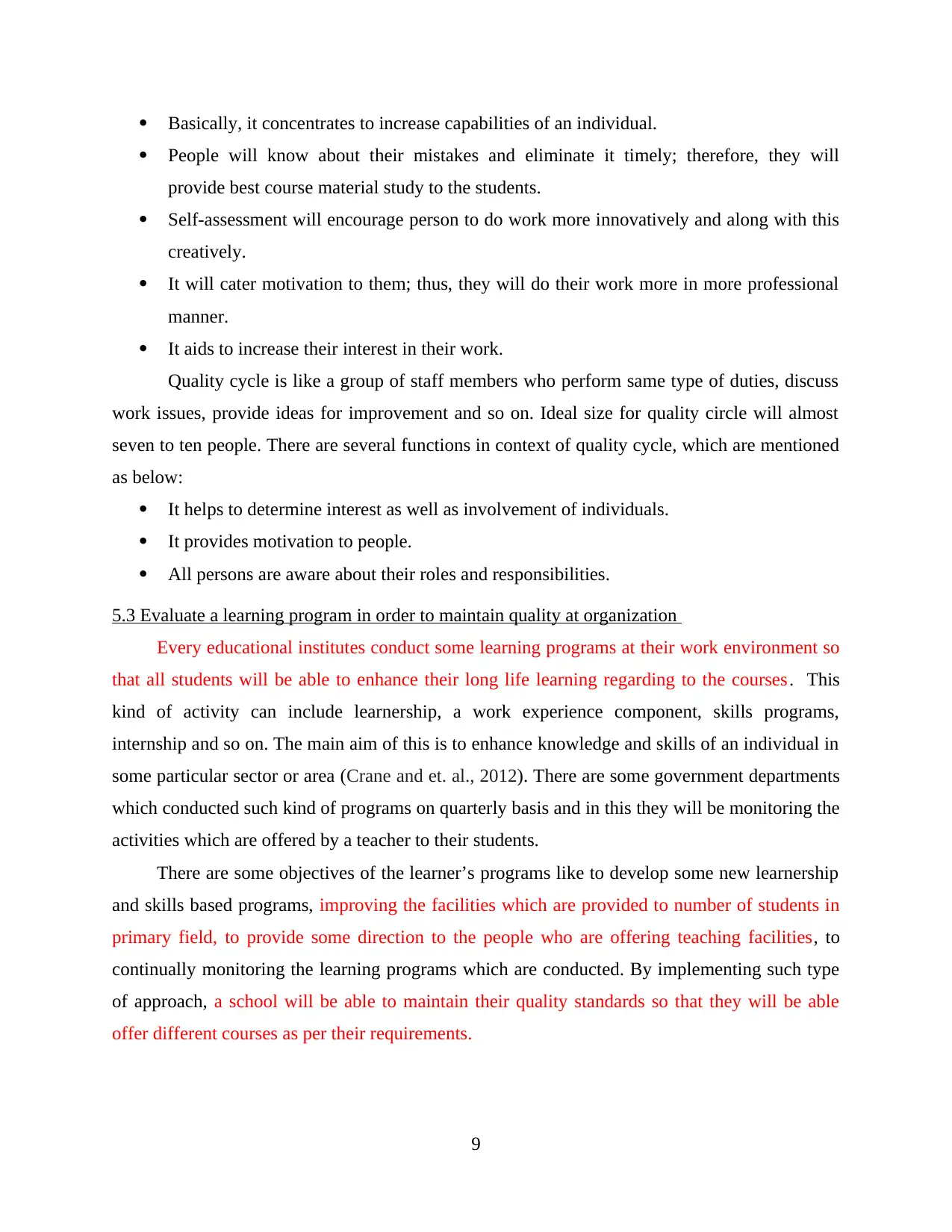
Basically, it concentrates to increase capabilities of an individual.
People will know about their mistakes and eliminate it timely; therefore, they will
provide best course material study to the students.
Self-assessment will encourage person to do work more innovatively and along with this
creatively.
It will cater motivation to them; thus, they will do their work more in more professional
manner.
It aids to increase their interest in their work.
Quality cycle is like a group of staff members who perform same type of duties, discuss
work issues, provide ideas for improvement and so on. Ideal size for quality circle will almost
seven to ten people. There are several functions in context of quality cycle, which are mentioned
as below:
It helps to determine interest as well as involvement of individuals.
It provides motivation to people.
All persons are aware about their roles and responsibilities.
5.3 Evaluate a learning program in order to maintain quality at organization
Every educational institutes conduct some learning programs at their work environment so
that all students will be able to enhance their long life learning regarding to the courses. This
kind of activity can include learnership, a work experience component, skills programs,
internship and so on. The main aim of this is to enhance knowledge and skills of an individual in
some particular sector or area (Crane and et. al., 2012). There are some government departments
which conducted such kind of programs on quarterly basis and in this they will be monitoring the
activities which are offered by a teacher to their students.
There are some objectives of the learner’s programs like to develop some new learnership
and skills based programs, improving the facilities which are provided to number of students in
primary field, to provide some direction to the people who are offering teaching facilities, to
continually monitoring the learning programs which are conducted. By implementing such type
of approach, a school will be able to maintain their quality standards so that they will be able
offer different courses as per their requirements.
9
People will know about their mistakes and eliminate it timely; therefore, they will
provide best course material study to the students.
Self-assessment will encourage person to do work more innovatively and along with this
creatively.
It will cater motivation to them; thus, they will do their work more in more professional
manner.
It aids to increase their interest in their work.
Quality cycle is like a group of staff members who perform same type of duties, discuss
work issues, provide ideas for improvement and so on. Ideal size for quality circle will almost
seven to ten people. There are several functions in context of quality cycle, which are mentioned
as below:
It helps to determine interest as well as involvement of individuals.
It provides motivation to people.
All persons are aware about their roles and responsibilities.
5.3 Evaluate a learning program in order to maintain quality at organization
Every educational institutes conduct some learning programs at their work environment so
that all students will be able to enhance their long life learning regarding to the courses. This
kind of activity can include learnership, a work experience component, skills programs,
internship and so on. The main aim of this is to enhance knowledge and skills of an individual in
some particular sector or area (Crane and et. al., 2012). There are some government departments
which conducted such kind of programs on quarterly basis and in this they will be monitoring the
activities which are offered by a teacher to their students.
There are some objectives of the learner’s programs like to develop some new learnership
and skills based programs, improving the facilities which are provided to number of students in
primary field, to provide some direction to the people who are offering teaching facilities, to
continually monitoring the learning programs which are conducted. By implementing such type
of approach, a school will be able to maintain their quality standards so that they will be able
offer different courses as per their requirements.
9
⊘ This is a preview!⊘
Do you want full access?
Subscribe today to unlock all pages.

Trusted by 1+ million students worldwide
1 out of 15
Related Documents
Your All-in-One AI-Powered Toolkit for Academic Success.
+13062052269
info@desklib.com
Available 24*7 on WhatsApp / Email
![[object Object]](/_next/static/media/star-bottom.7253800d.svg)
Unlock your academic potential
Copyright © 2020–2025 A2Z Services. All Rights Reserved. Developed and managed by ZUCOL.


